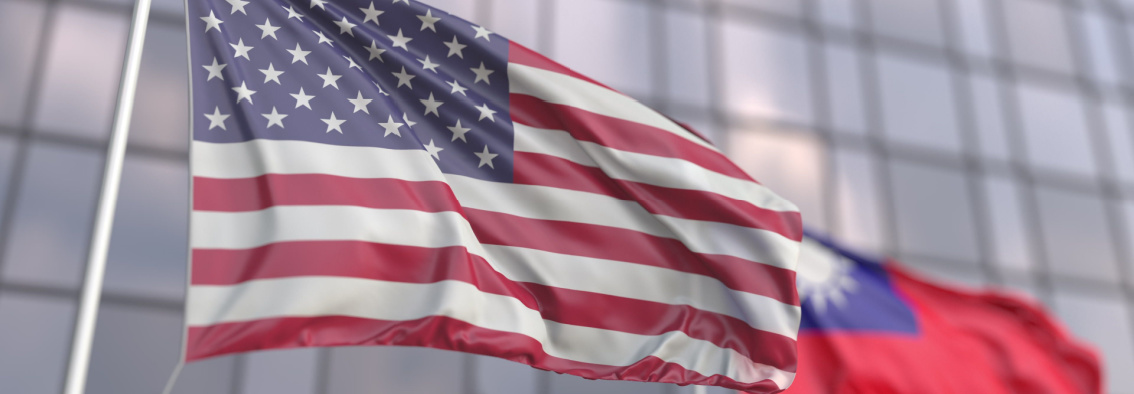In November of last year, North Carolina Department of Commerce Secretary Machelle Baker Sanders announced that the state had officially opened an investments office in Taiwan. While the announcement flew somewhat under the radar at the time, it was nevertheless a significant development for Taiwan. In fact, the opening of the North Carolina office marked the culmination of what was a banner year for Taiwan’s relations with US states, with several other states—including Arizona and Virginia—inaugurating their own offices in Taiwan earlier in the year. These offices have been complemented by a flurry of other interactions, including a growing number of delegations of state government officials to Taiwan. Amid the People’s Republic of China’s (PRC) tireless efforts to restrict Taiwan’s ability to interact on a country-to-country basis, these growing sub-national ties with individual US states could prove increasingly valuable, potentially providing Taipei with crucial opportunities to diversify its economic connections, build political support, and enhance its people-to-people relations.
Sub-National Diplomacy Between Taiwan and US States
While the federal government of the United States continues to be a strong supporter of Taiwan, its actions are fundamentally constrained by its overall approach to cross-Strait relations, as outlined in the Taiwan Relations Act (TRA), the Three Communiqués, and the Six Assurances. These documents—though broad enough to allow for a fairly comprehensive, mutually beneficial relationship—have historically prevented Washington from engaging in more direct, “official” forms of diplomacy with counterparts in Taipei. As a result of these limitations, the United States does not operate an official embassy in Taiwan, largely avoids high-profile engagements with Taiwanese officials (then-House Speaker Nancy Pelosi’s 2022 trip to Taiwan notwithstanding), and maintains a deliberately vague, circumspect tone in its international discussions of Taiwan and its status. While the majority of these constraints are largely symbolic in nature, they have nevertheless placed something of a ceiling on US-Taiwan relations, preventing the partnership from reaching the level of other, and more formal, alliances.
Recognizing these limitations, as well as the potential benefits of building ties with Taiwan, a broad range of US states have conducted their own outreach to the island democracy. Strictly speaking, these efforts have taken place in a sort of constitutional gray zone, as the US constitution explicitly forbids states from engaging in any sort of foreign diplomacy, exclusively placing such responsibilities under the purview of the federal government. However, as the Congressional Research Service (CRS) has noted, this provision has not prevented states—as well as cities and counties—from building substantive ties with foreign counterparts. Indeed, per CRS, such entities “play a more prominent role in international relations than may be generally recognized.” Generally, states have effectively circumvented Congressional oversight of these activities by simply not notifying Congress about them.
State Representative Offices in Taiwan
Historically, Taiwan has provided a unique test case for this arrangement, particularly on the economic front. While the federal government has long demonstrated a reluctance to engage in comprehensive trade and investment talks with Taiwan—despite Taipei’s strong advocacy—many states have shown no such compunction. As Don Shapiro noted in his comprehensive report on Taiwan-state relations, a number of states have opted to engage directly with Taiwanese counterparts, signing memoranda of understanding (MOUs), exchanging trade delegations, and opening trade and investment offices. These efforts have unfolded alongside—but independently of—the federal government’s outreach to Taiwan.
Notably, Shapiro emphasized that such outreach is not necessarily a new phenomenon, as several states have maintained decades-long relationships with Taiwan. In fact, the high-water mark for state-level ties with Taiwan was in the early 2000s, when 22 states operated some form of representative office in the country. However, with the US-PRC relationship on the rise in the late 2000s and early 2010s, many of these states opted to close down their Taiwan offices and reallocate resources to the mainland. This shift was reinforced by the PRC’s increasingly harsh rhetoric toward Taiwan and its supporters, which led some state governments to eschew ties with Taiwan in an effort to avoid Beijing’s ire.
Thankfully for Taiwan, this trend seems to have changed course in recent years. This reversal has likely been driven by a variety of factors. Perhaps most notably, US goodwill toward the PRC has largely evaporated, with Beijing’s growing authoritarianism, increasingly undeniable human rights abuses, and abrasive diplomacy eroding public perceptions and feeding distrust. This decline in US support for China has only accelerated since 2018, in the wake of China’s crackdown in Hong Kong, the US-China trade war, and Beijing’s controversial handling of the COVID-19 pandemic. And while the Biden Administration has taken some steps to reengage with the PRC, the relationship remains cold and distant—thereby diminishing state-level interest in expanding operations on the mainland.
At the same time, Taiwan has proven successful in distinguishing itself on the world stage, particularly on the economic front. Led by corporations such as Taiwan Semiconductor Manufacturing Company (TSMC, 台灣積體電路製造股份有限公司), Taiwan has become increasingly well-known as a source of high-tech goods, technological expertise, and foreign direct investment (FDI). Like many other nations—including Japan, Germany, and other European states—the United States has recognized this potential and sought to encourage Taiwanese investment. These efforts have been highlighted by TSMC’s 2020 announcement that it would be constructing a multi-billion-dollar semiconductor fabrication plant outside Phoenix, Arizona.
In the wake of this investment—and with US-Taiwan relations on the upswing more broadly—a growing contingent of states have sought to expand their own ties with Taiwan. As the chart below shows, the number of state representative offices in Taiwan has increased dramatically over the past five years, with 12 states setting up operations since 2019, while others—such as New Jersey—are poised to continue the trend in the near future. All told, a total of 17 states (and the US territory of Guam) have established offices, a remarkable change in such a short time.
State | Date of Office Establishment |
1989 | |
1989 | |
1990 | |
1990 | |
1994 | |
2009 | |
2018 | |
2020 | |
2021 | |
2021 | |
2021 | |
2022 | |
2022 | |
2022 | |
2023 | |
2023 | |
2023 | |
2023 |
Table: Current US state representative offices in Taiwan (Source: Compiled by author)
As Shapiro and others have noted, these offices are by no means identical to one another. Reflecting the diversity of the states that established them, such offices exist for a variety of purposes, and are administered through a variety of mechanisms. While some exist purely to encourage Taiwanese investment in the state, others have broader mandates, including facilitating tourism, enhancing collaboration in specific industrial sectors, and streamlining bilateral imports and exports. Administratively, some offices are run directly by state agencies, while others are overseen by non-profits or state business councils.
While each state has undertaken its own unique approach to Taiwan, their interactions are generally overseen by the American State Offices Association (ASOA), which “works to coordinate, co-organize and support trade, investment, education and tourism related activities.” With 20 members—including the aforementioned 18 states and territories, as well as two state-affiliated business organizations from Ohio and New York—the organization acts as a facilitator in Taiwan, connecting members with viable partners in the country. In doing so, it works closely with the American Chamber of Commerce in Taiwan (AmCham Taiwan).
Rising Sub-National Linkages
While the recent proliferation of state offices in Taiwan has been perhaps the most visible indication of Taiwan’s growing ties with individual US states, other developments suggest that these relationships are becoming more sustainable. Of particular note has been the surge of state-level delegations to Taiwan, which have grown increasingly common of late. As Shapiro noted, “Taiwan has welcomed the leaders of Arizona (twice, by two different governors), Indiana, Idaho, Michigan, Montana, New Jersey, New Mexico, and Virginia” over the past two years alone. Generally, these visits have included large contingents of state trade officials and business representatives, who have built connections and engaged in negotiations with Taiwanese counterparts.
Partly as a result of these efforts, many states have been successful in securing substantial Taiwanese investment. These include (but are not limited to):
- Over USD $40 billion in investment in Arizona by TSMC
- Over USD $193 million in investment in New Mexico by various Taiwanese firms
- Over USD $34 million in investment in West Virginia by Far Eastern New Century Corporation (FENC, 遠東新世紀)
- Over USD $11 million in investment in Kentucky by various Taiwanese firms
Beyond investment, many states have significantly increased their bilateral trade with Taiwan, with import and export numbers surging in recent years. This growth has been particularly notable for Virginia, with Governor Glenn Youngkin noting during a 2023 delegation that his state’s exports to Taiwan had increased 27 percent since 2020, while imports from Taiwan had topped USD $1 billion annually. Outside of Virginia, other states have reported strong trade numbers, including Arizona, New Mexico, and Hawaii.

Image: Virginia Governor Glenn Youngkin meets with Taiwan President Tsai Ing-wen in April 2023. (Image Source: Taiwan Office of the President)
In addition to these quantitative gains, increased engagement between US states and Taiwan has allowed for notable expansions of educational, cultural, and people-to-people ties. For instance, since 2020 alone, Taiwan has signed 26 education-focused MOUs with 24 states, with many focusing on Mandarin language education. With many states working to restrict or eliminate the activities of Beijing’s Confucius Institutes on college campuses, these MOUs have set the stage for Taiwan to fill the void with its Taiwan Centers for Mandarin Learning (TCML).
New Paths for Taiwan
For Taiwan, these interactions with US states could help to provide a model for navigating an increasingly perilous and claustrophobic international order. As demonstrated by the February decision by the Pacific island state of Nauru to sever ties with Taipei, Beijing’s campaign to isolate and marginalize Taiwan is unlikely to abate anytime soon. Accordingly, it will be increasingly necessary for Taiwan to develop new, more nuanced approaches to international relations, even as its list of formal partners continues to shrink. By capitalizing on its highly productive engagements with a growing list of US states, Taipei may have found a route to circumventing PRC pressure and carving out diplomatic breathing room, albeit at a sub-national level.
As Shapiro has noted, Taiwan appears to have recognized the value of these ties. In recent years, Taiwan’s diplomatic corps has worked to expand its connections with state governments and business groups. Taiwan has also dispatched numerous trade delegations to various US states, which have met with elected officials, negotiated MOUs, and broadly increased Taiwan’s visibility in the business sector. Meanwhile, Taiwan’s universities have made similar in-roads, signing agreements with state university systems and working to fill the vacuum once filled by PRC institutions.
In isolation, each of these interactions may be dismissed as relatively inconsequential. In the aggregate, however, they suggest that Taiwan may be refining its approach in a meaningful way. Indeed, in many nations, Taiwan seems to have turned some of its focus toward smaller, more subtle, sub-national linkages. While undoubtedly less flashy than high-level, government-to-government agreements, these sorts of ties could allow Taiwan to operate in a wider range of environments, building productive connections even in the most unlikely of locations. And though the United States is hardly an unfriendly environment for Taiwan, these recent successes indicate that this more focused approach could bear fruit elsewhere.
The main point: In recent years, Taiwan has proven successful in building productive ties with a growing list of US states. While these relationships are undoubtedly valuable in their own right, they could also provide a template for Taiwan to adopt a more subtle, sub-state approach to international relations going forward.
The author would like to thank GTI Spring 2024 Interns Uma Baron and Willian Hung for their research assistance.



